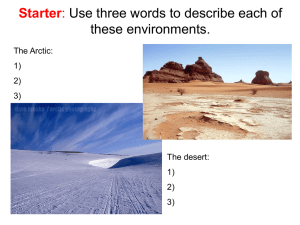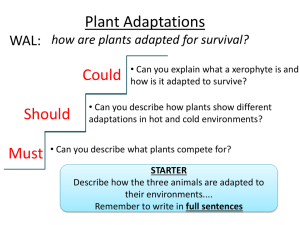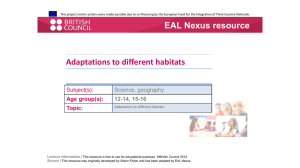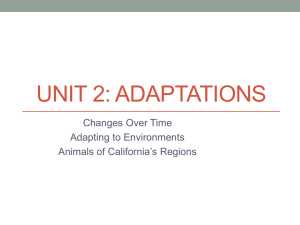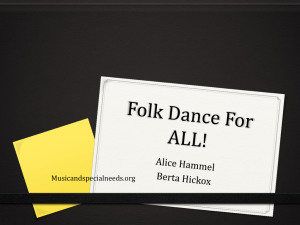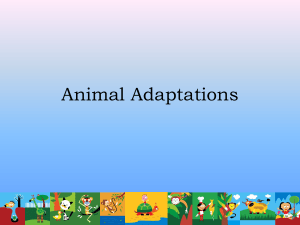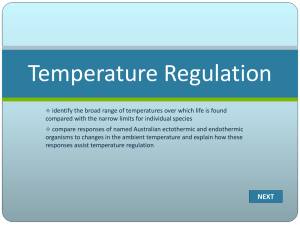Adaptations PPT
advertisement
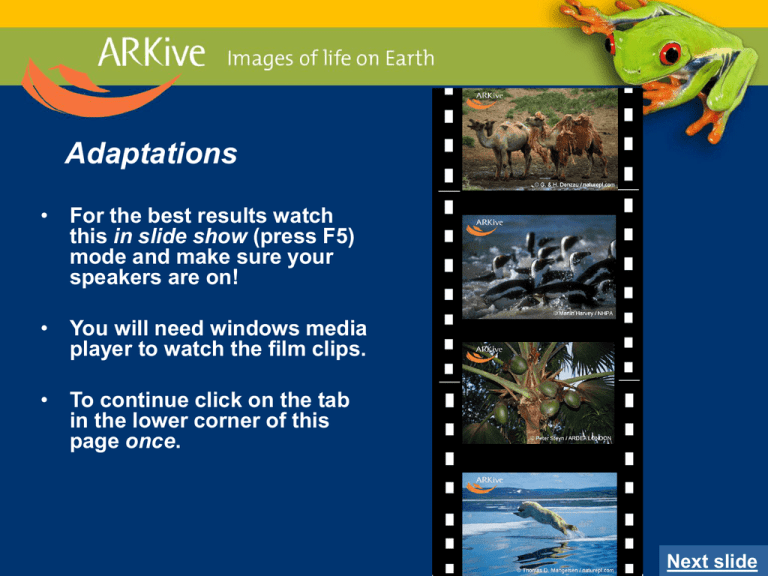
Adaptations • For the best results watch this in slide show (press F5) mode and make sure your speakers are on! • You will need windows media player to watch the film clips. • To continue click on the tab in the lower corner of this page once. Next slide A feature that helps a living thing to survive is called an “adaptation” e.g. thick fur in cold places. Can you pick out the four best adaptations for polar climates by clicking them below? Thick layer of fat and hollow oily fur. Long eyelashes. A short snout or nose. Small ears and a very rounded body. Claws and large, cup like feet. A long snout or nose. When you have found all four correct adaptations for cold climates click here A feature that helps a living thing to survive is called an “adaptation” e.g. thick fur in cold places. Can you pick out the four best adaptations for polar climates by clicking them below? Thick layer of fat and hollow oily fur. Well done! A thick layer of fat and hollow oily fur keep the polar bear warm and help the bear float. Click here to go back and pick another A feature that helps a living thing to survive is called an “adaptation” e.g. thick fur in cold places. Can you pick out the four best adaptations for polar climates by clicking them below? A short snout or nose. Sorry, but this isn’t a useful adaptation in a cold climate. A short snout or nose won’t allow air that is breathed in time to warm up before it enters the lungs, which leads to heat loss. Click here to go back and pick another A feature that helps a living thing to survive is called an “adaptation” e.g. thick fur in cold places. Can you pick out the four best adaptations for polar climates by clicking them below? Claws and large, cup like feet. Well done! Claws act like ice picks and large cup-like feet act like rubber to provide grip and friction on ice and snow. Click here to go back and pick another A feature that helps a living thing to survive is called an “adaptation” e.g. thick fur in cold places. Can you pick out the four best adaptations for polar climates by clicking them below? Sorry, ice builds up on eyelashes in polar regions! Long eyelashes are a more useful adaptation for dusty or sandy environments as they stop dust and sweat entering the eye. Long eyelashes. Click here to go back and pick another A feature that helps a living thing to survive is called an “adaptation” e.g. thick fur in cold places. Can you pick out the four best adaptations for polar climates by clicking them below? Well done! Small ears and a very rounded body shape help to prevent heat loss as they reduce the surface area and lower the risk of frostbite on the extremities. Small ears and a very rounded body. Click here to go back and pick another A feature that helps a living thing to survive is called an “adaptation” e.g. thick fur in cold places. Can you pick out the four best adaptations for polar climates by clicking them below? Well done! This adaptation allows inhaled air to warm up before it enters the lungs. A long snout or nose. Click here to go back and pick another Adaptations A feature that helps a living thing to survive is called an “adaptation” e.g. thick fur in cold places. Thick layer of fat and hollow oily fur for warmth and to help the bear float. Small ears, long snout, and a very rounded body shape to prevent heat loss. Question: What other adaptations are there? Click above to play film Claws act like ice picks and large cup like feet act like rubber to provide grip and friction. Next slide Adaptations A feature that helps a living thing to survive is called an “adaptation” e.g. large eyes are more effective in darkness (they take in more light). Q. Name three different physical features (adaptations) the wild Bactrian camel has that help it to survive in the desert. e.g. humps that store fat supplies. Click above to play film Next slide Adaptations Watch the film clip Q. In which of these habitats would you expect this particular iguana to be found most of the time just by looking at its physical adaptations (features)? Click above to play film Rainforest Rocky shore ? ? ? ? Farmland Watch the film on the next page to find out if you were right Desert Next slide Adaptations And the correct answer is….. Click above to play film Q. What are its adaptations? Next slide The marine iguana's adaptations are: • A blunt nose for grazing algae (seaweed) from rocky shores. • Long claws and powerful grip for clinging to rocks. • A more streamlined shape for cutting through water. • A flatter wider tail for swimming underwater. Next slide Plants have adaptations too such as rolled, hairy or waxy leaves to hold in water and deep roots to tap into water supplies: This film clip shows the Coco-demer palm tree’s “seed”. It is one of the largest, heaviest (and one of the toughest) seeds in the world. Q. Why might these adaptations have developed over many generations of palm trees? Click above to play film Next slide Adaptations • • It is thought that the seeds developed because they needed to survive the long journeys at sea, where saltwater would normally ruin seeds that were less sturdy and resistant. In addition to this they have to survive the drop from the top of the palm tree (up to 34 metres) Click above to play film Next slide Adaptations Remember: A physical feature that helps a living thing to survive is called an “adaptation” e.g. camouflage to hide from prey or predators or deep roots to find water. Click above to play film Q. Name two adaptations that snow leopards have. Next slide The snow leopard’s adaptations are: • Camouflage helps to hide them from prey. • Thick fur helps them to keep warm. • A long tail for balance. • Forward facing eyes (like most predators) to pick out detail and to judge distances accurately. See www.arkive.org for more film clips, images and information on globally endangered species First slide
